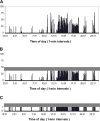Nonlinear analysis of ambulatory activity patterns in community-dwelling older adults
- PMID: 19822625
- PMCID: PMC2806237
- DOI: 10.1093/gerona/glp144
Nonlinear analysis of ambulatory activity patterns in community-dwelling older adults
Abstract
Background: The natural ambulatory activity patterns of older adults are not well understood. User-worn monitors illuminate patterns of ambulatory activity and generate data suitable for analysis using measures derived from nonlinear dynamics.
Methods: Ambulatory activity data were collected continuously from 157 community-dwelling older adults for 2 weeks. Participants were separated post hoc into groups based on the mean number of steps per day: highly active (steps > or = 10,000), moderately active (5,000 < or = steps < 10,000 steps), and inactive (steps <5,000 steps). Detrended fluctuation analysis (DFA), entropy rate (ER), and approximate entropy (ApEn) were used to examine the complexity of daily time series composed of 1-minute step count values. Coefficient of variation was used to examine time series variability. Between-group differences for each parameter were evaluated using analysis of variance.
Results: All groups displayed patterns of fluctuating step count values containing complex temporal structure. DFA, ER, and ApEn parameter values increased monotonically and significantly with increasing activity level (p < .001). The variability of step count fluctuations did not differ among groups.
Conclusions: Highly active participants had more complex patterns of ambulatory activity than less active participants. The results supported the idea that, in addition to the volume of activity produced by an individual, patterns of ambulatory activity contain unique information that shows promise for offering insights into walking behavior associated with healthy aging.
Figures

Comment in
-
Chasing a theoretical basis for the definition and analysis of nonlinear patterns of activity in older adults.J Gerontol A Biol Sci Med Sci. 2010 Nov;65(11):1254-5; author reply 1256-8. doi: 10.1093/gerona/glq085. Epub 2010 Jun 3. J Gerontol A Biol Sci Med Sci. 2010. PMID: 20522530 No abstract available.
References
-
- Jylha M, Guralnik JM, Balfour J, Fried LP. Walking difficulty, walking speed, and age as predictors of self-rated health: the women's health and aging study. J Gerontol A Biol Sci Med Sci. 2001;56(10):M609–M617. - PubMed
-
- Guralnik JM, Ferrucci L, Pieper CF, et al. Lower extremity function and subsequent disability: consistency across studies, predictive models, and value of gait speed alone compared with the short physical performance battery. J Gerontol A Biol Sci Med Sci. 2000;55(4):M221–M223. - PubMed
-
- Simonsick EM, Newman AB, Nevitt MC, et al. Measuring higher level physical function in wellfunctioning older adults: expanding familiar approaches in the Health ABC study. J Gerontol A Biol Sci Med Sci. 2001;56(10):M644–M649. - PubMed
-
- Podsiadlo D, Richardson S. The timed “up and go”: a test of basic functional mobility for frail elderly persons. J Am Geriatr Soc. 1991;39:142–148. - PubMed
-
- Adamson J, Hunt K, Ebrahim S. Association between measures of morbidity and locomotor disability: diagnosis alone is not enough. Soc Sci Med. 2003;57(8):1355–1360. - PubMed
Publication types
MeSH terms
Grants and funding
LinkOut - more resources
Full Text Sources
Research Materials

